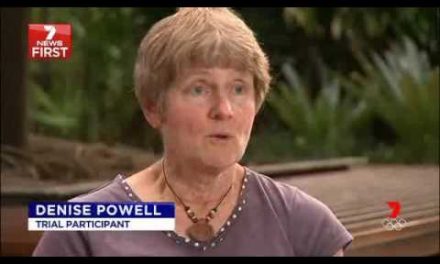In the aftermath of a puppy mill bust, the youngest dogs are often ready for adoption as soon as they’re weaned and given a good scrubbing.
But after years of abuse and isolation, the older dogs need far more than a bath.
Responding to cruelty cases nationwide, behaviorists at the American Society for the Prevention of Cruelty to Animals found themselves overwhelmed with dogs that were literally afraid of their own shadows — they’d never seen them before, because they’d never seen sunlight.
These extremely fearful dogs come from what the ASPCA calls impoverished environments. They’ve lived their whole lives in barren rooms or tied up in open fields, often with nothing but their littermates and their own filth. Everything about living in a home — not just vacuum cleaners, but couches and ceilings and bookshelves — is utterly foreign and can push them into catatonic fear.
“They simply (aren’t) placeable. They don’t go into homes and recover with just time and love,” Kristen Collins, vice president of ASPCA rehabilitation services said.
In 2013, the ASPCA embarked on a pilot rehabilitation program in a small New Jersey shelter. “The idea was just to honestly ask the question — can we rehabilitate these animals? Can we save them?” Collins said.
Exceeding their wildest expectations, about 87% of the dogs who entered ASPCA rehabilitation programs since 2013 have graduated to forever homes. In 2018, Collins’ vision for a permanent refuge for fearful dogs was realized in a purpose-built, $9 million ASPCA Behavioral Rehabilitation Center in Weaverville.
Situated on 13 acres, the facility can treat up to 65 dogs at a time in kennels designed to minimize stress. In addition to treating and studying fearful dogs, the ASPCA sees the BRC as the first of several knowledge-sharing hubs. After refining their protocols for years, the ASPCA plans to share what they’ve learned with rescues across the country.
The behavioral rehabilitation program is an anti-boot camp — slow paced and gentle, it guides dogs along a road to home paved with cheesy treats and incremental progress.
Here’s how.
The ‘floofs’
Looking around the Weaverville Behavioral Rehabilitation Center, it looks like there’s been a glitch in the matrix.
A massive Iowa puppy mill bust in 2018 stacked the BRC with nearly identical Samoyeds. They’re big white dogs, mischievous and highly athletic, bred to work as hunting and sled dogs in the harsh Siberian plains. Now, Samoyeds are popular in American households for their impressive “floof” and beguiling smile.
But crammed into a commercial breeding facility in northern Iowa, they were hardly recognizable.
“There were about 150 of them that came off that property and they were living in squalor,” Collins said. “They had no food, no unfrozen water…like pretty much all puppy mills, they have no contact with people, or limited contact with people at best.”
Rescuers found eight or nine dogs shoved into runs meant for one, their white coats stained black with filth.
Twenty four of the Samoyeds arrived at the center for treatment, among them Nova, a 6-month-old with severe anxiety.
“We start very slowly with behavior modification so that we can ease them into life as pet dogs,” Collins explained.
“On average, it’s a 13-week treatment time,” Collins said. “Our fastest cases can zoom through in two to three weeks … outliers on the other end are with us much longer.”
‘Drive-buy treating’
When dogs first begin treatment at the BRC, the first goal is to form a positive association with humans. Touch is out of the question. Since many of these animals haven’t ever played with a toy — and are, in fact, terrified of them when first introduced — the ASPCA finds cheese is an excellent ambassador.
Drive-by treating is a low-stakes conditioning game that even the most fearful pups can tolerate, Collins explained, tossing bits of cheese to trembling dogs as nonchalantly as possible.
“When you walk through, just do all the things that are most benign when it comes to scared dogs — turn your body to the side, don’t make direct eye contact,” she said. “It’s all about us continuing to move so that they only get exposure to us for a second.”
As the dogs’ cowering gives way to chop-licking, behaviorists begin readying them for life as a pet.
Dotted throughout the pods are what appear to be tiny studio apartments, “real life rooms” designed to expose the dogs to home environments.
In real life rooms, volunteers lounge on futons while skeptical pups keep an eye on the bookshelf in the corner. The behaviorists will practice exposing the dog to new people and new objects.
To a fearful dog, ceiling fans feel like “these spinning blades of doom,” and couches can seem like big hulking creatures.
“It’s amazing which things are the most spooky for specific animals — like, a potted plant,” Collins said. “Those really seemingly benign things are often (what) set them off.”
Helper dogs
Survivors of hoarding and puppy mills see something to fear at every turn. But there’s one thing they’re almost guaranteed to be accustomed to — being around lots and lots of other dogs.
During play group, skittish Speck looked to Lily Jane, a squat border collie mix and proud graduate of the program, for reassurance before slinking up to the handler offering him a blob of canned food.
After seven years locked in a dark barn, Lily Jane arrived at the ASPCA so terrified she’d poop with fear. After graduation, she was adopted by a BRC staff member.
“A really crucial part of the rehab involves pairing dogs who are less fearful with dogs who are new,” Collins said. “That makes a big, big difference because obviously they’ve never had social partners in a person.” But dogs they trust.
“Helper dogs are really what moves them forward,” Marvin said. When Nova arrived, “we already had a group of Samoyeds that had been in the program for weeks…she would rush right over to them.”
“But then when we started coming close, she would take off,” she explained. “So we used (her relationship to the helper dogs) to our advantage.”
They’d bring one of the other Samoyeds to Nova’s kennel when she was reluctant to leave.
“She would start getting curious,” Marvin said. “That’s how her journey really got started.”
With her newfound social confidence, the trainers were able to start one-on-one sessions with Nova. But interacting with people was still work for her, not fun. “Her reward would be coming back to play with other dogs.”
But as Nova became more secure, her personality blossomed.
“There’s absolutely nothing like that feeling,” Collins said. “To see them have joy for the first time.”
With toys added to their treatment toolbox, a trainer took Nova out to an open field to see if she’d play with a human partner. “She just came alive. She just started pouncing and playing and became really social with her. That was a really huge breakthrough.”
Birth of a troublemaker
As she progressed further, Nova was promoted to “office time” — when the dogs hang out administrative side of the building.
Paradoxically, the trainers knew their work with Nova was almost done when she started to act out. ”(Nova began to) pull things down from the top of the crate, she’d put her paws up (on desks) and pull things down. She would take the broom and just run with it,” Marvin said.
“From a rehabilitation standpoint, that’s huge. That’s a breakthrough because it shows confidence — curious confidence.”
Nova graduated in 20 weeks — the milestone hundredth alum of the program. She was placed for adoption at the Asheville Humane Society, where May Toropova, one of Nova’s human parents, scooped her up.
Toropova said Nova is thriving in her new home, playing chase with her canine siblings and making steady progress in trusting people.
Collins acknowledged that the kind of individualized, long-term treatment fearful dogs need is resource intensive — and not feasible for every shelter in the country.
But the ASPCA envisions the behavioral center as the first of many regional hubs where partner organizations can come to trade notes on best practices through the BRC’s Learning Lab initiative.
The BRC offers on-site, dorm-style accommodations for visiting rescue groups free of charge.
https://www.fayobserver.com/news/20200203/nc-program-rehabs-puppy-mill-survivors-paralyzed-by-fear












